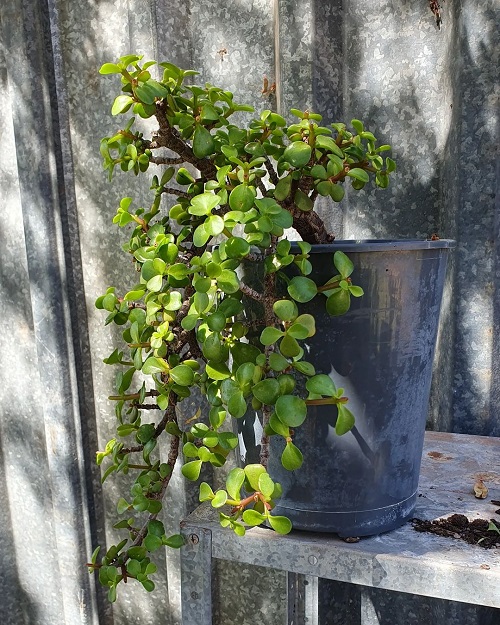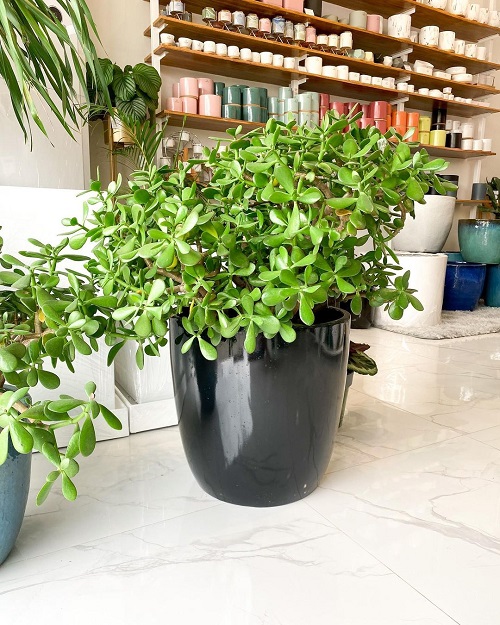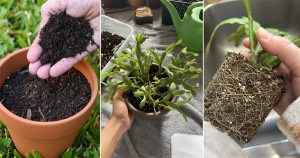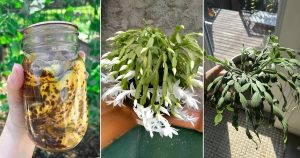Elephant Bush vs Jade Plant—Are you confused between the two, too? Don’t worry! This article will clear everything out!
When it comes to popular and beloved succulent species, the elephant bush and jade plant often find themselves in the spotlight of confusion! Let’s end this Elephant Bush vs Jade Plant debate once and for all!
Elephant Bush (Portulacaria afra)
This South African native has small, glossy leaves that look like tiny jade leaves, and its reddish-brown stems look beautiful. If you let it, it can grow into a large, multi-branched shrub, reaching up to 8-15 feet tall in the wild. Just be careful with watering; it has moderate needs and doesn’t appreciate being over-watered.
Think of it like a guest who likes a drink but doesn’t want to be drowned. Elephant Bush loves basking in full sun to partial shade and thrives in well-draining soil. It’s a bit of a diva when it comes to temperature, preferring above-freezing conditions. But don’t worry, it’s easy to care for and you can prune it to keep it looking just the way you like.
Jade Plant (Crassula ovata)
Jade Plant, a succulent superstar from Mozambique and South Africa. It has fleshy, thick, oval leaves boast a rich jade green color, and its sturdy, woody stems look beautiful. Crassula ovata typically growing up to 3-6 feet tall, it’s perfect for any space. Unlike the Elephant Bush, the Jade Plant doesn’t need much water and is quite drought-tolerant. It’s like the camel of the succulent world—able to go without water for ages!
The Jade Plant loves soaking up the sun but can also do well in partial shade. Plant it in well-draining soil and it’ll be happy. Although it’s sensitive to frost, it can handle slightly cooler temperatures than the Elephant Bush. Plus, it’s super easy to grow and doesn’t need much pruning. And, if you often forget to water your plants, the Jade Plant is your perfect match—it’s as low-maintenance as they come!
Elephant Bush vs Jade Plant—Similarities
These two succulents have a lot in common and it’s like they were cut from the same cloth!. Both hail from southern Africa and have a bushy growth habit with shiny green leaves. They thrive in well-draining soil, need moderate watering, and love plenty of sunlight. As succulents, they store water in their leaves and stems, making them tough and easy to care for.
Elephant Bush vs Jade Plant—Differences

Now, let’s talk differences. The Elephant Bush has rounded leaves and can grow much larger in its natural habitat compared to the more compact Jade Plant. While both are drought-tolerant, the Jade Plant can go longer without water. The Elephant Bush might be the life of the party, but the Jade Plant is the marathon runner—steady and long-lasting!
In terms of cold tolerance, the Jade Plant can handle slightly cooler temperatures. The Elephant Bush usually has reddish-brown stems, whereas the Jade Plant’s stems are more woody and grayish.
Factors to Consider
Still torn between the two? Think about your space. If you’re short on room, the more compact Jade Plant might be the way to go. If you want something you can shape into a larger bonsai, the Elephant Bush could be your best bet. Also, consider your watering habits; if you tend to forget, the drought-tolerant Jade Plant is a safer choice. Remember, it’s all about finding the right plant for your lifestyle—choose wisely!
And of course, think about which plant’s appearance you prefer. Both are great for bonsai, but the Elephant Bush is particularly well-suited for it. Lastly, consider your local climate. The Jade Plant handles slightly cooler temperatures, which might be important if you live in an area with chilly winters.
Final Thought!
In the end, both the Elephant Bush and Jade Plant are beautiful, easy-to-care-for succulents that can thrive in similar conditions. Whichever you choose, you’re in for a treat! Your choice will likely come down to personal preference and specific growing conditions. So, what do you prefer? Share your experiences and choices in the comments below!







